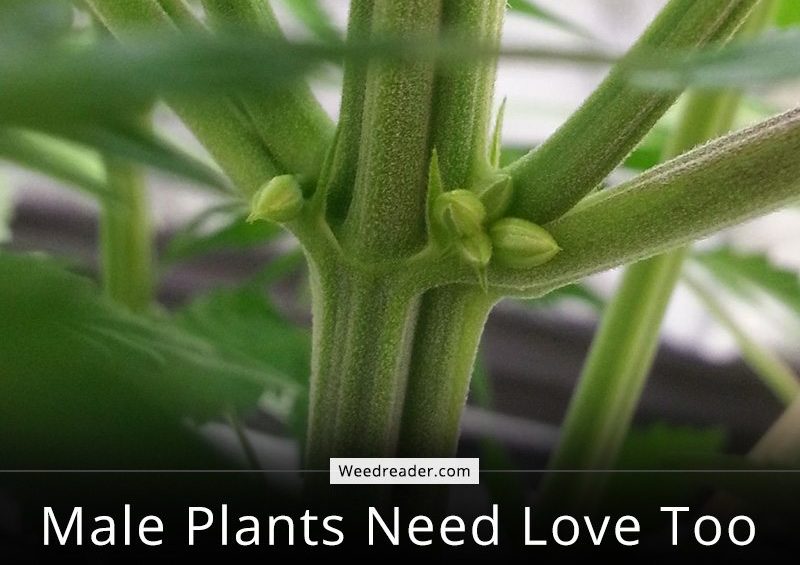Cannabis is an unusual plant.
It provides feeds, heals, clothes, powers and heals humanity. In addition to being the most useful plant known to man, cannabis is also reproduces in a rare way. Due to the special way it procreates, cultivators value the female plants far above the male.
Unlike most plants, marijuana produces sexually. Female plants produce the large, resinous flowers (called buds or colas) while the males produce the pollen. Once the female plant is pollinated, it switches from producing resin to seeds.
Once the plants begin producing seeds, they stop producing THC so farmers with pollinated crops cannot make as much money. It is because of this change that most cannabis farmers remove the male plants from their gardens. If a grower wants to continue a line of plants after harvest, they can clone the female plants.
Cloned plants are genetic copies of their parents.
Cannabis is amazing on so many levels. If you cut the tip of a plant off and place the clipping in a sugary liquid, it can sprout roots and grow into a new plant. This process is called cloning and it bypasses the plants normal reproductive cycle.
The clone is always a genetic copy of the parent. In addition to producing a copy of the parent ( i.e. guaranteed female plants), clones grow faster than starting from seed. But there are still some issues with cloning.
Cloning isn’t perfect.
Over generations of time, clones build up genetic mistakes. Like our own bodies, plant genes are copied and replicated over and over. Small mistakes in the copying process often lead to drastic variations in the end result. The most common result of cloning multiple generations is reduced potency and vitality.
After about four or five generations of cloning, the original genetic code begins showing signs of decay. This normally takes the form of reduced THC production, increased sensitivity to pests and diseases along with unpredictable changes to the overall shape/growth characteristics of adult clones.
Growers mitigate this issue by cycling their clones. Basically, every couple of generations the grower will start a new line from seed. This resets the genetic drift and reestablishes a base point. While cloning ensures that a specific arrangement of genes remains essentially intact, there are still random mutations in the cloning process.
Male plants are pretty useful.
Breeding a male and female plant bypasses the degrading effects of cloning. When pollinating females, male plants also provide half of the genetics inherited by the seed. Their shape, rate of growth, pest and mold resistance, and climate resilience effect the resulting seeds.
Breeders use this to their advantage. They can mix and match elements to create new variations. Female plants that produce heavy yields but have poor mold resistance are bred with males that resist mold well. It can take a few tries to get the right mix of features but eventually a viable, stable seed is produced.
Hemp producers love male plants.
When it comes to hemp fiber, there is a difference in male and female plants. The male cannabis plant produces a softer material while female plants create a coarser, stronger fiber. The soft fiber from the male plants are more desirable for products like clothing, tablecloths, and household items. The strong fiber of the females is better for cording or rope.
Male plants can also produce concentrates. Yes, females produce more cannabinoids than males but that doesn’t mean the males are worthless in this area. While significantly lower in cannabinoids than female plants, male plants can be extracted into hash or other oils just as easily.
Male plants also help in other gardens.
Cannabis plants offer more benefits to a garden than simple bud production. Both male and female cannabis plants produce aromatic oils called terpenes. Terpenes are aromatic chemicals produced by many plants that help in pest and disease control.
Additionally, cannabis plants have deep roots with long taproots. Taproots dive deep into the ground and break apart low-quality soil. This allows moisture and nutrients to infiltrate and improve the soil quality. They also hold the soil in place, preventing nutrient runoff and loss of soil during heavy rains.
Don’t forget the males.
If you intend to play around with male plants, just remember that they are REALLY good at finding females. A single male plant left to its own devices can pollinate females miles away. If you aren’t specifically breeding cannabis, having males can cause issues for neighbors and anyone without a hermetically sealed grow tent.
Humans generally destroy male cannabis plants when found. And for most people, this protects their crops. But it’s important to acknowledge and cherish male cannabis plants. Females may produce the buds we love, but by removing the males, we could be losing out on future benefits.
There is a lot we still don’t know about cannabis. There could be a whole host of compounds we still haven’t discovered yet. Specific males could play a significant role in how females develop, or how cannabis is developed in the future. But until more research is done, remember that male plants need love too.





